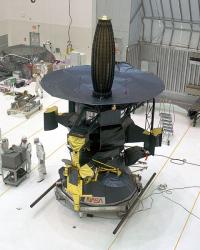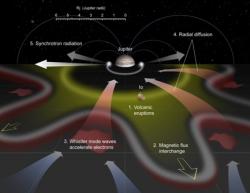Jupiter has a powerful magnetic field 20,000 times stronger than the Earth’s. It is therefore of no surprise that the highly energetic and damaging particles flying around in the Earths Van Allen Belts can be found within Jupiter’s magnetosphere too. But are the mechanisms energizing these particles the same for both planets? New research suggests that the magnetospheres of Jupiter and Earth may have more in common than previously thought…
As previously reported on Universe Today, there is a possible source to the magnetospheric “hiss” that energizes protons and electrons within the Earth’s Van Allen Belts. The discovery that low frequency “chorus” waves propagating through the upper atmosphere evolve into waves that can interact with charged particles is significant in that it helps to solve a 40 year debate as to where these waves come from. Now, the nature of Jupiter’s highly energetic particles trapped in its strong magnetic field has been brought into question.

The Galileo spacecraft (pictured) measured radio wave activity inside the magnetosphere as it orbited the gas giant over eight years. According to the scientific collaboration including researchers at the British Antarctic Survey (BAS), University of California, Los Angeles (UCLA), and the University of Iowa (UI), similar low frequency radio waves may be responsible for electron energization in the Jovian high energy particle belts as in the terrestrial Van Allen Belts.
Although details on the source of Earth’s “chorus” waves are sketchy (we know they originate outside of the plasmasphere surrounding Earth and evolve into a radio wave “hiss” inside the Van Allen Belts), the source of low frequency radio waves around Jupiter comes from the interactions between the moon Io and the Jovian magnetic field.
“On Jupiter, the waves are powered by energy from volcanoes on the moon Io, combined with the planet’s rapid rotation – once every 10 hours. Volcanic gasses are ionized and flung out away from the planet by centrifugal force. This material is replaced by an inward flow of particles that excite the waves that in turn accelerate the electrons.” – Dr Richard Horne, lead author of research, British Antarctic Survey (BAS).
The interaction of Jupiter’s moons with its atmosphere is highlighted when analysing the pattern of the polar auroral regions on the planet. As the magnetic field is so strong on Jupiter, massive regions of bright emission can be seen in the UV wavelengths (pictured top). This is emission from huge auroral displays as highly energetic particles funnel down magnetic flux and interact with Jupiter’s atmosphere (similar to Earth’s auroral displays, only much bigger). There are some strange patterns in the auroral “crown” – “footprints” of the Jovian moons, Io, Ganymede and Europa. The moons emit particles which get directed down to Jupiter by the gas giant’s magnetic field. These footprints appear as little spots in Jovian polar regions, rotating with the moons as they pass through the magnetosphere.

By far the strongest influence on Jupiter’s magnetosphere, Io is constantly erupting with material, firing it through the Jovian magnetic field. Thanks to Galileo data, it appears this fast orbiting moon generates low frequency radio waves, driving the high energy particles trapped within Jupiter’s plasmasphere through wave-particle interactions.
“For more than 30 years it was thought that the electrons are accelerated as a result of transport towards Jupiter, but now we show that gyro-resonant wave acceleration is a very important step that acts in concert.” – Dr Horne
These results will have a huge impact on space weather forecasting. As the Sun erupts during periods of heightened solar activity (i.e. during “solar maximum”), the reaction of the Earth’s plasmasphere is critical to understanding the quantities of damaging high energy particles that may influence space missions, damaging satellites and causing harm to astronauts. Looking into Jupiter’s huge magnetosphere will aid understanding of our own magnetosphere, hopefully improving solar storm predictions.
Source: British Antarctic Survey

